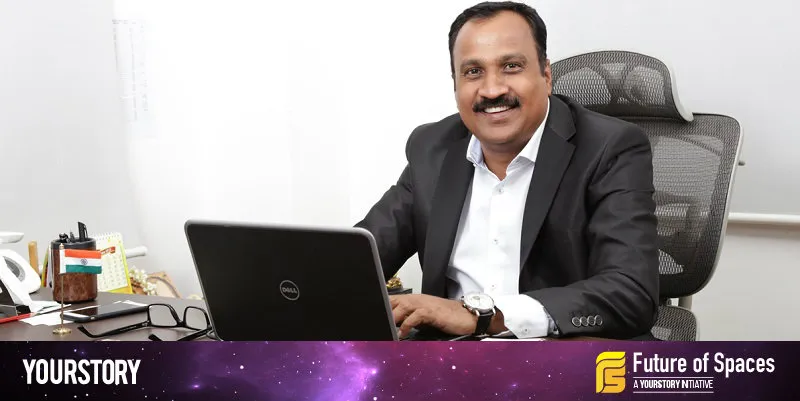How this GE Six Sigma Black Belt went from constructing a friend's house to building a Rs 220 cr business
In 16 years, Bengaluru-based Sowparnika has completed over 35 projects and made a mark as an affordable real estate company; Founder Ramji Subramaniam, who believes the focus on millennials has helped, aims to scale in the next few years.
Not many people transition from a corporate job to becoming a mid-sized real estate giant. But Ramji Subramaniam, who worked in sourcing and operations at General Electric for 14 years, didn’t realise when his part-time work became serious business. He now runs Bengaluru-based Sowparnika Projects, a real estate firm that claims more than 35 completed projects, 30 ongoing projects, over 6,000 customers, and a strong presence in the three states of Karnataka, Tamil Nadu, and Kerala. The company is eyeing Rs 220 crore in revenue this year.
The Sowparnika journey started in 2003 when Ramji’s friend was struggling to build his own house. Ramji said he would manage the sourcing and contracting for the house in exchange for a small sum. “I had a Six Sigma qualification from GE, and I knew how to source things and organise a project; that gave me the confidence to try my hand at construction,” he says.

He roped in his wife Meenakshi and brother Sreenivasan to join him and run a partnership firm to construct homes in Bengaluru.
However, it took a good five years before it became a corporate business. Between 2003 and 2008, the trio focused on building homes and 10-12 unit apartments. By then, the partnership firm had grown to revenues worth Rs 40 crore, which led Ramji to quit his corporate job and work on Sowparnika full time.
The early days
The American housing-led recession hit in 2008 and globally, industries were cutting costs. But, the slowdown did not hit India until 2011. Real estate continued to grow; according to the RBI, lending to real estate increased by 15 percent.
“We began our journey with private debt; now we have gone to bigger institutions such as Edelweiss and IIFL,” Ramji says. He adds that the company has a debt of Rs 150 crore on its balance sheet. “We focused on the value segment, which made us grow faster,” Ramji says.
Real estate has been going through a prolonged glut for the last eight years. Government reforms, including the Real Estate Regulation Act, protected customers from fly-by-night builders. In fact, details from industry sources show that more than 16,000 projects are delayed in North India. “The industry is over leveraged and, we were lucky to grow because we focused on the younger generation of home owners,” Ramji says.
Focusing on the millennial
By 2012, when the real estate industry began to slow down, Ramji decided to tap a completely new market. He realised that many millennials were migrating to Bengaluru and Coimbatore to study, and were looking for cheaper options to stay.
Sowparnika began constructing one-room, 600 square feet studio apartments priced at Rs 15 lakh. Five of these projects, with 150 units each, sold out by 2016. This helped the company grow from Rs 200 crore in revenues in FY2017, to Rs 210 crore in the last financial year. This year, they aim to close at Rs 220 crore. But the growth journey isn’t over yet; Ramji expects to reach Rs 300 crore by the end of 2019-2020.
“I believe we were able to focus on value housing and built a brand name. It was very important that we modernised our business processes and went from being a partnership firm to a corporate business. The transition was only possible because of my experience in the corporate world,” he says.
Sowparnika even started low EMI products for the millennial customer; this allowed them to pay 5 percent down payment to book a house and not pay an EMI until they received possession of the house. When the EMI kicked in, the company returned the down payment and gave the customer a time frame - usually a few extra months - to pay back the down payment.
Since then, the company has expanded its business in towns around Bengaluru, including Hoskote, Sarjapur, and Whitefield. It has expanded its footprint to Thiruvananthapuram and Mysore, but will continue to focus on smaller towns.
Building on a strong foundation
According to IBEF, the real estate sector in India is expected to reach a market size of $1 trillion by 2030 from $120 billion in 2017, and make up 13 percent of the country’s GDP by 2025. Sowparnika competes with the likes of developers like Sumadhura, Hoysala, and Divyashree. The latter two companies have gone on to build bigger projects.
Sowparnika plans are to add at least five projects per year and may contemplate an IPO in the future.
Ram Chandnani, Managing Director, Advisory and Transactions at CBRE, says: “It is clear that smaller towns, close to bigger cities, are also looking for good real estate. We see that with several people migrating to work or study in these cities.”
Ramji strongly believes in the Six Sigma approach to guide his life, by defining, measuring, analysing, improving, and controlling all situations. And from GE to Sowparnika, he believes Six Sigma has helped him forge his way and grow.







